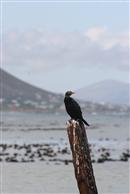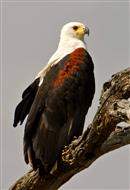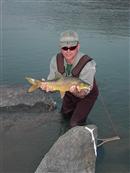 Agriculutre runoff can impact water quality. Source:Ramon 2008 ( click to enlarge ) |
 Discarded barrels that were used to contain Persistent Organic Pollutants (POPs) can become a source of contamination. Source:©iStockphoto/Urbanija 2006 ( click to enlarge ) |
 Mine tailings south of Johannesburg; although often carefully managed degrade over time, releasing acid and radioactive particles into the air and nearby watercourses. Source:Kruchem 2008 ( click to enlarge ) |
 Oxide precipitation facility at Emalahleni, South Africa. Source:Kruchem 2011 ( click to enlarge ) |
 Members of the eMalahleni Water Reclamation Plant Public-Private-Partnership consortium, present at the signing of the cooperation agreement. Source:Vogel 2011 ( click to enlarge ) |
 Irrigation in the Kalahari relies on groundwater. Source:Christelis 2008 ( click to enlarge ) |
 Look-up table for fitness- for-use of water. Source:DWA South Africa 2009 ( click to enlarge ) |
 Orange River at Upington. Source:Paffy 2006 ( click to enlarge ) |
 The Orange-Senqu River basin is home to a unique array of biodiversity. Source:Vogel 2009 ( click to enlarge ) |
 The Khubelu River in Lesotho. Source:Lesotho Water Commission 2002 ( click to enlarge ) |
 The Carbon cycle. Source:Pidwirny 2006 ( click to enlarge ) |
 The Senqu River, Lesotho. Source:Lesotho Water Commission 2008 ( click to enlarge ) |
 The Orange River Mouth, a designated Ramsar wetland. Source:Agar 1998 ( click to enlarge ) |
 Despite the significant pressures from developments in the basin, the rivers of the Orange-Senqu River system host rich aquatic communities. Source:Lesotho Water Commission 2002 ( click to enlarge ) |
 All birds, including this Cape Cormorant, are heterotrophs because they cannot harness the sun's energy. Source:MBoy68 2007 ( click to enlarge ) |
 An example of a food web (FPOM= Fine Particulate Organic Matter). Source:Hatfield 2007 ( click to enlarge ) |
 This figure illustrates energy flows related to the accumulation of biomass in an individual animal. Energy is obtained through food, while energy is consumed or lost in metabolic processes (i.e., respiration) and the excretion of wastes. Source:NTEAP 2007 ( click to enlarge ) |
 African Fish Eagle. Source:De Wet 2006 ( click to enlarge ) |
 Small Mouth Yellowfish (Rubber Lips). Source:Inkwazi Fly Fishing 2009 ( click to enlarge ) |
 Trypanosoma sp.- the protozoa responsible for African Sleeping Sickness. Source:Centre for Disease Control 2006 ( click to enlarge ) |
